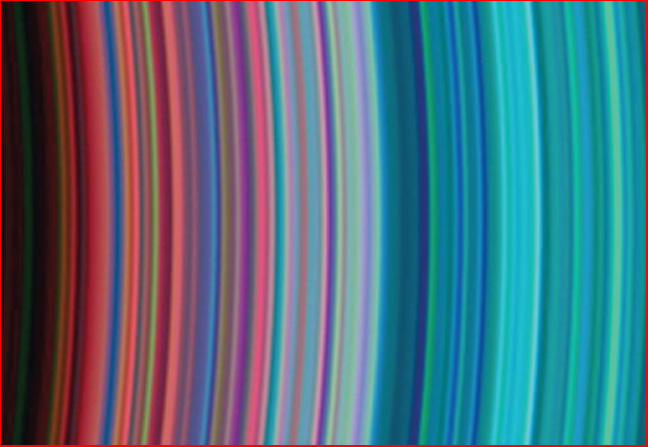
Thousands of sorted bands in Saturn's rings. Credit: NASA/JPL
Posted on 03/16/2008 2:49:59 AM PDT by Swordmaker

Mar 06, 2007
Saturn's Plasma RingA toroid of charged particles around Saturn could indicate electrical discharges from the planet.
In a recent press release about Cassini's unusual findings in its exploration of Saturn, NASA officials announced the discovery of "hot particles" surrounding the planet in a toroid, or doughnut-shaped, ring. The most peculiar aspect to their findings was that it is not symmetrical.
"It's curious that Saturn's ring current isn't symmetric," said Don Mitchell, an astrophysicist at Johns Hopkins University who helped examine the images beamed back to Earth. "We think the solar wind is squishing the sunward side of the ring current, kind of like a wind sock."
A similar torus of particles surrounds Earth with electrons moving eastward and positive ions moving to the west. These charged particles are, in reality, plasma and the motion around the Earth constitutes an electric current. The 'doughnut' of plasma around Saturn is the same effect.
According to the press release, planets with magnetic fields can trap hot particles to form giant electrified clouds. However, as we have noted in these pages, from an electric universe perspective, the warm rilles and hot poles of Saturn's moon Enceladus are electrically heated and vapor is being electrically "machined" from where the current flowing through it returns to Saturn's sheath circuit. The oxygen and hydrogen in the water vapor are probably what feeds charged particles into Saturn's plasmasphere.
NASA scientists have noticed the "bending" of Saturn's magnetic field around Enceladus "due to electric currents generated by the interaction of atmospheric particles and the magnetosphere of Saturn." But their blind spot with regard to plasma behavior leads them to insist that the electric currents "don't do anything."
The distortion of the torus on the sunward side indicates that an electrical (not mechanical) effect is occurring between Saturn and the sun. By referring to it as a "wind sock", Cassini mission specialists are betraying their ignorance of electricity in space – especially the currents that flow through space-borne plasma.
Electrical theorist Don Scott comments:
"Yes they refuse to acknowledge that moving electrical charges constitute an electric current (there are no 'wind socks' in space). There is a significant density of electrons and ions in 'empty' space however. Magnetic fields do not trap 'hot' particles any better than they do cold particles. When did you ever see a bar magnet attract cigarette smoke, for example? Magnetic fields can only affect streams of electric charges (currents)"
Another of the distinctive features thought to be "mysterious" by the data analysts is a clump of electrified particles synchronized with the planet's rotation.
"Saturn is a big fast rotator. The clump seems loosely hooked to the planet, yet rotates with it," Mitchell said. "It may be connected with Saturn's ring current, but we just don't know. This is something we're working very hard to figure out."
Don Scott comments once more:
"I wish them luck. I do feel they would stand a better chance of it if they would drop the 'wind sock' mindset and begin to recognize how magnetic and electric fields interact with streams of charge. Nearby electric current can distort a magnetic field. A congestion of electric charge may be due to a concentrated electric field along some particular radius vector emanating up from the planet."
Every so often Saturn breaks out with a 'great white spot' three times larger than Earth. Standard models of Saturn and a gravity-only cosmos cannot explain such a periodic outburst, but an intense lightning discharge deep in the atmosphere could cause vertical jets very similar to the sprites in Earth's upper atmosphere. Electrical effects and its connection to the current flow in the solar system can explain most of the effects that Cassini and other science packages have discovered on and around Saturn. As we reported in a previous Thunderbolts Picture of the Day:
"The solar cycle connection explains not only the changes in lightning patterns on Saturn, but also the expanded magnetosphere and the (now) missing spokes. The higher electrical stress throughout the solar system in 1980/1981 would have compressed Saturn's magnetosphere and created the dark spokes. (The spokes revolved to the tune of Saturn's magnetic field rather than to gravity's rules, suggesting they were electrical discharges across the rings. And each separate spoke began when Saturnian "dawn" reached the longitude associated with the long-lasting equatorial storm.) The lower stress of solar minimum allows the magnetosphere to relax, the spokes to fade, and the "storms" to migrate toward higher latitudes.
Could something like that explain the Giant Red Spot on Saturn?
Disclaimer: Opinions posted on Free Republic are those of the individual posters and do not necessarily represent the opinion of Free Republic or its management. All materials posted herein are protected by copyright law and the exemption for fair use of copyrighted works.